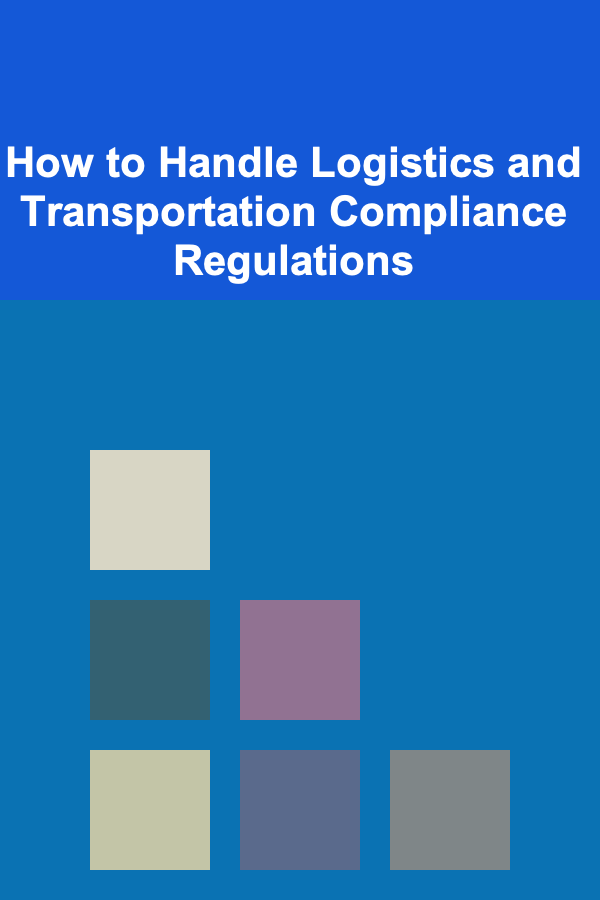
How to Handle Logistics and Transportation Compliance Regulations
ebook include PDF & Audio bundle (Micro Guide)
$12.99$9.99
Limited Time Offer! Order within the next:

In today's globalized economy, logistics and transportation play a pivotal role in the smooth functioning of businesses. Whether you are shipping goods domestically or internationally, adhering to logistics and transportation compliance regulations is crucial to ensuring the timely and legal movement of goods. Non-compliance with regulations can result in costly fines, legal penalties, or even disruptions to your supply chain. In this actionable guide, we will explore how businesses can effectively navigate logistics and transportation compliance regulations, covering key aspects, actionable strategies, and best practices.
Understanding Logistics and Transportation Compliance Regulations
Logistics and transportation compliance regulations are rules that businesses must follow to ensure their goods are transported legally and safely across jurisdictions. These regulations cover various aspects of transportation, including safety standards, environmental protections, security, and proper documentation.
Key Areas of Logistics and Transportation Compliance:
- Safety Regulations: Includes vehicle standards, hazardous materials handling, driver qualifications, and transportation safety measures.
- Environmental Regulations: Regulations designed to minimize the environmental impact of transportation, such as emissions limits and fuel efficiency standards.
- Customs and Import/Export Regulations: Regulations governing cross-border shipments, including tariffs, duties, and necessary customs documentation.
- Security Regulations: Measures aimed at protecting goods during transport, preventing theft, and complying with national security protocols.
- Labor Regulations: Laws related to driver working hours, wages, and employment standards.
The Challenges of Compliance
Handling logistics and transportation compliance is not without its challenges. Regulations vary widely across different countries, states, and regions, and they are often subject to change. This dynamic landscape can create a sense of uncertainty and complexity for logistics professionals. The key challenges include:
- Complexity of Multi-Jurisdictional Rules: Companies operating internationally must navigate different regulatory frameworks in each country they do business in.
- Frequent Changes in Legislation: Regulations can change frequently, and staying up-to-date on the latest laws and rules is crucial.
- Cost of Non-Compliance: Fines, legal costs, and damaged reputations due to non-compliance can severely impact a business.
- Technological Integration: Many compliance regulations require the use of specific technologies for tracking, documentation, or reporting.
Step-by-Step Guide to Handling Logistics and Transportation Compliance
1. Stay Informed About Relevant Regulations
The first step in managing compliance effectively is to stay informed about the regulations that apply to your business. These regulations can come from various sources, including local, state, national, and international authorities. Key regulatory bodies include:
- U.S. Federal Motor Carrier Safety Administration (FMCSA) for transportation within the U.S.
- European Union (EU) Regulations for companies operating in Europe.
- World Customs Organization (WCO) for international trade regulations.
- Environmental Protection Agency (EPA) for environmental compliance.
- International Maritime Organization (IMO) for maritime transport.
Staying informed involves regularly checking the websites of these agencies, subscribing to compliance updates, and even attending industry conferences or webinars.
2. Implement a Compliance Management System (CMS)
A well-designed Compliance Management System (CMS) is vital for managing logistics and transportation regulations efficiently. A CMS helps track compliance requirements and ensures that you can respond quickly to regulatory changes.
Key Features of an Effective CMS:
- Centralized Documentation: All compliance-related documents, including permits, certificates, and regulations, should be stored in an easily accessible system.
- Automated Alerts: Set up notifications or alerts for regulatory deadlines or changes in compliance requirements.
- Real-Time Monitoring: Implement tracking tools to monitor vehicles, shipments, and inventory in real time, ensuring compliance with regulations.
- Audit Trails: Maintain detailed logs of compliance activities for easy auditing and reporting.
A CMS helps ensure that nothing is overlooked and that compliance becomes part of the daily operations rather than an afterthought.
3. Train Employees on Compliance Regulations
Employee training is one of the most effective ways to ensure logistics and transportation compliance. Employees involved in logistics should be well-versed in the regulations that apply to their specific roles. This includes:
- Drivers: Drivers should be trained on road safety regulations, hours of service, and the handling of hazardous materials (if applicable).
- Logistics Managers: Managers should have a comprehensive understanding of all logistics compliance regulations, including international trade laws and customs requirements.
- Warehouse Workers: Those handling goods should be trained in proper packaging, labeling, and documentation to ensure compliance with safety and environmental regulations.
- Customs Brokers: Ensure that brokers are familiar with the customs and import/export regulations for the specific markets your business serves.
Training should not be a one-time event but rather an ongoing process. Regular refresher courses and updated materials should be provided to ensure everyone is on the same page.
4. Ensure Proper Documentation
Proper documentation is at the heart of compliance in logistics and transportation. It's essential to have all necessary paperwork in order before transporting goods. This may include:
- Bills of Lading (BOL): A legal document that outlines the terms of the shipment and serves as proof of receipt of goods.
- Customs Declarations: Documents that provide information on goods being imported or exported, including their value, origin, and classification.
- Hazardous Materials Documentation: Special documentation for the transportation of dangerous goods, including safety data sheets (SDS) and certificates of compliance.
- Vehicle Inspection Records: Maintain records of vehicle inspections to comply with safety standards.
Establish a process to verify that all documentation is accurate, up-to-date, and compliant with the relevant laws.
5. Adopt Technology Solutions for Compliance
Technology can significantly ease the process of maintaining logistics and transportation compliance. By integrating advanced software systems and tools, you can streamline various aspects of compliance, from real-time tracking to document management.
Key Technology Solutions to Consider:
- Transportation Management Systems (TMS): These systems help plan, execute, and monitor the transportation of goods. A TMS can track shipments, monitor vehicle performance, and ensure compliance with delivery schedules.
- Electronic Logging Devices (ELDs): For truck drivers, ELDs automatically record driving hours and rest periods to comply with hours-of-service regulations.
- Automated Compliance Checks: Software can be used to check shipments against regulatory requirements for safety, hazardous materials, and customs.
- Blockchain for Documentation: Blockchain technology offers a secure and transparent way to manage shipping documents, which can help with compliance in international trade.
Leveraging technology not only improves compliance but also enhances efficiency and reduces human error.
6. Conduct Regular Audits
Auditing is essential to ensure that your business is staying compliant with logistics and transportation regulations. Regular internal audits should be conducted to evaluate how well your business is adhering to the regulations.
Key Areas to Audit:
- Documentation: Ensure that all shipping documents, including permits, bills of lading, and customs declarations, are in order.
- Vehicle Inspections: Review vehicle maintenance logs to verify compliance with safety standards.
- Training and Certifications: Confirm that employees are up-to-date on required training and certifications.
- Record-Keeping: Check that all compliance-related records are accurate and easily accessible for audits.
Audits help identify gaps in compliance and allow you to address them before they become significant problems.
7. Stay Agile and Adapt to Regulatory Changes
Regulations are constantly evolving, and companies must stay flexible and adapt quickly. In recent years, there has been a growing trend toward stricter environmental regulations, such as reduced carbon emissions for freight transport. Similarly, new trade agreements and security concerns can lead to changes in customs requirements.
Actionable Strategies to Stay Agile:
- Monitor Regulatory Trends: Stay informed about emerging trends in transportation regulations. Use industry publications, webinars, and regulatory alerts to stay ahead of potential changes.
- Build Relationships with Regulatory Bodies: Establishing relationships with relevant regulatory authorities can help you stay informed about upcoming changes and gain insights into how new rules might impact your operations.
- Be Ready to Invest in Upgrades: Be prepared to invest in new technologies, certifications, or equipment to meet evolving regulatory standards.
By staying agile, your business can avoid compliance-related disruptions and remain competitive.
Conclusion
Handling logistics and transportation compliance regulations is a complex but crucial task for any business involved in the movement of goods. By staying informed, implementing a robust compliance management system, training employees, adopting technology, and conducting regular audits, you can ensure that your operations remain compliant and efficient.
As regulatory landscapes continue to evolve, it's essential to stay proactive, adapt to changes, and continuously improve your processes. Compliance is not just about avoiding penalties; it's about fostering trust with your customers, partners, and stakeholders, ultimately contributing to the long-term success of your business.

How to Create a Checklist for Car Transmission Maintenance
Read More
How to Create a Kid-Friendly Storage System
Read More
How to Make Money Online as a Graphic Designer
Read More
How to Offer Group Music Lessons and Increase Your Earnings
Read More
How to Stage Your Home to Highlight Natural Light
Read More
How to Start Your Own Transportation Business with Your Car: An Actionable Guide
Read MoreOther Products

How to Create a Checklist for Car Transmission Maintenance
Read More
How to Create a Kid-Friendly Storage System
Read More
How to Make Money Online as a Graphic Designer
Read More
How to Offer Group Music Lessons and Increase Your Earnings
Read More
How to Stage Your Home to Highlight Natural Light
Read More